Reliving 100 years of France’s glorious banked racing circuit at Montlhéry
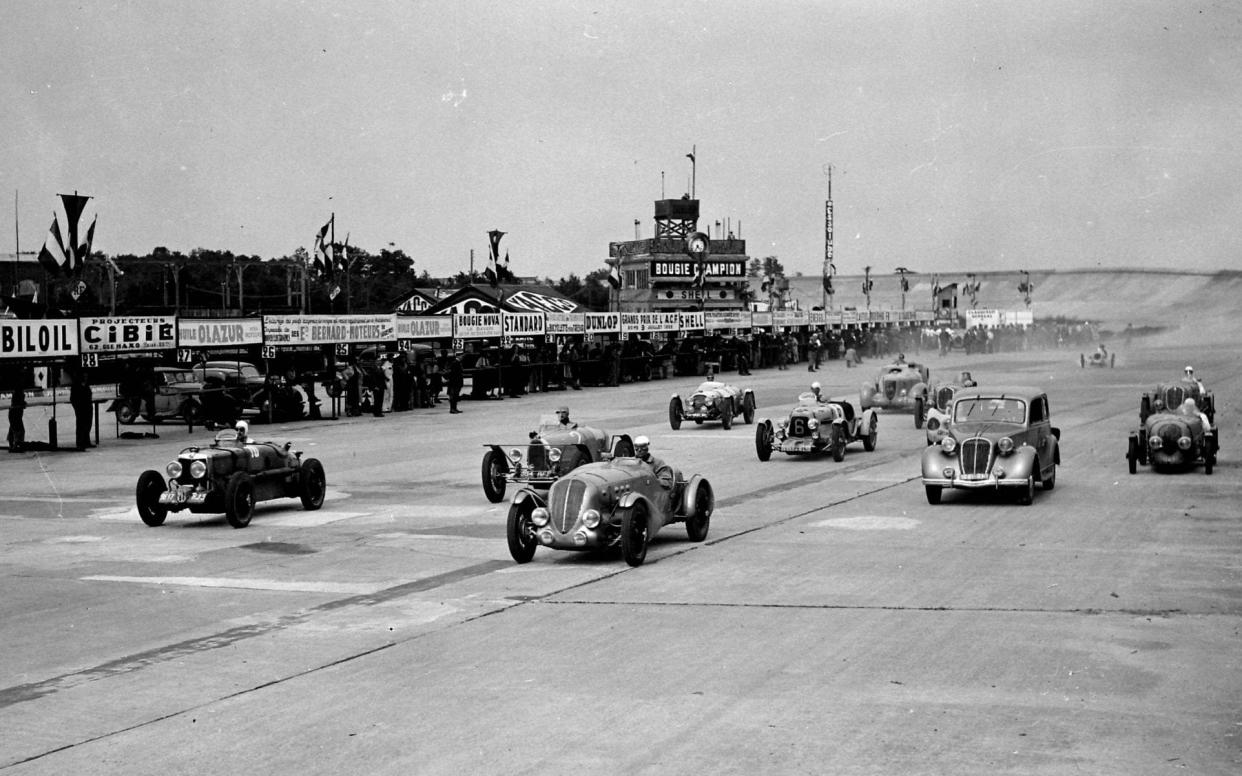
It seems hard to believe but at one time the French Grand Prix was held on this bare concrete bowl, which dwarfs the tiny cars crawling around its patched surface. Sporadically in the 1920s and 1930s, this extraordinary concrete construction at Montlhéry, south of Paris, hosted brave men and women and their ferocious machines, engaging in, as Bill Boddy puts it in his book Montlhéry: The Story of the Paris Autodrome: “Pure uninterrupted full-throttle motoring.”
Racing cars in those days were crude devices, without much in the way of cornering prowess. Instead, their massive aero engines tore round banked tracks emitting fire and brimstone, ready at any moment to devour their intrepid drivers. The sight was something to behold. A photograph of John Cobb in a Napier-Railton airborne on the Brooklands banking in the mid-1930s still sends shivers down my spine.
![English writes that this photograph 'still sends shivers down [his] spine'](https://s.yimg.com/ny/api/res/1.2/nFGe38yDmelzIP0XUr6BsQ--/YXBwaWQ9aGlnaGxhbmRlcjt3PTEyNDI7aD03NzY-/https://media.zenfs.com/en/aol_the_telegraph_624/2891dc0ebf46d55eedc1634e39be4f50)
Autodromes, a brief history
Autodromes such as Montlhéry came about as motor racing grew out of its infancy. After the first motor race, the 1894 Paris to Rouen event, was as notable for its retirements as its winners, motor racing became the sport du jour, especially after the First World War.
Early motor races were billed as being reliability trials, taking place on unsealed open roads, which would send up clouds of impenetrable dust. They were incredibly dangerous, with cars leaving the road, turning over and sometimes crashing into spectators, often with fatal results. But the public interest in the daring automobilists was insatiable. Thousands would amass to glimpse the spectacle. Pretty soon, businessmen and impresarios realised there was money to be made in hosting racing events and started looking for suitable venues.
Brooklands was first. The 2.767-mile banked concrete track was constructed in 1906 near Weybridge in Surrey and hosted its first race in 1907. It nearly bankrupted Hugh and Ethel Locke King, who owned the land and funded the building of the twin 30ft high bankings.
“The right crowd and no crowding,” they said, promoting the circuit where record-breakers, racers and socialites gadabouted, but the public couldn’t get enough of lantern-jawed drivers such as Henry Seagrave, John Cobb and Sir Malcolm Campbell and their mighty machines.
Close to major centres of population and with decent transport links, autodromes or speedways used the emerging techniques of ferro-reinforced Portland cement-based concrete, which was a relatively simple way of building complex structures quickly. Fiat’s five-storey Lingotto car factory, started in 1916 and inaugurated in 1923, used similar construction techniques. Indeed, if you walk under the concrete bowl at Montlhéry and look upwards at the construction, you see the network of fine beams and braces like a church roof in bleached-bone hued concrete very similar to that of Lingotto.
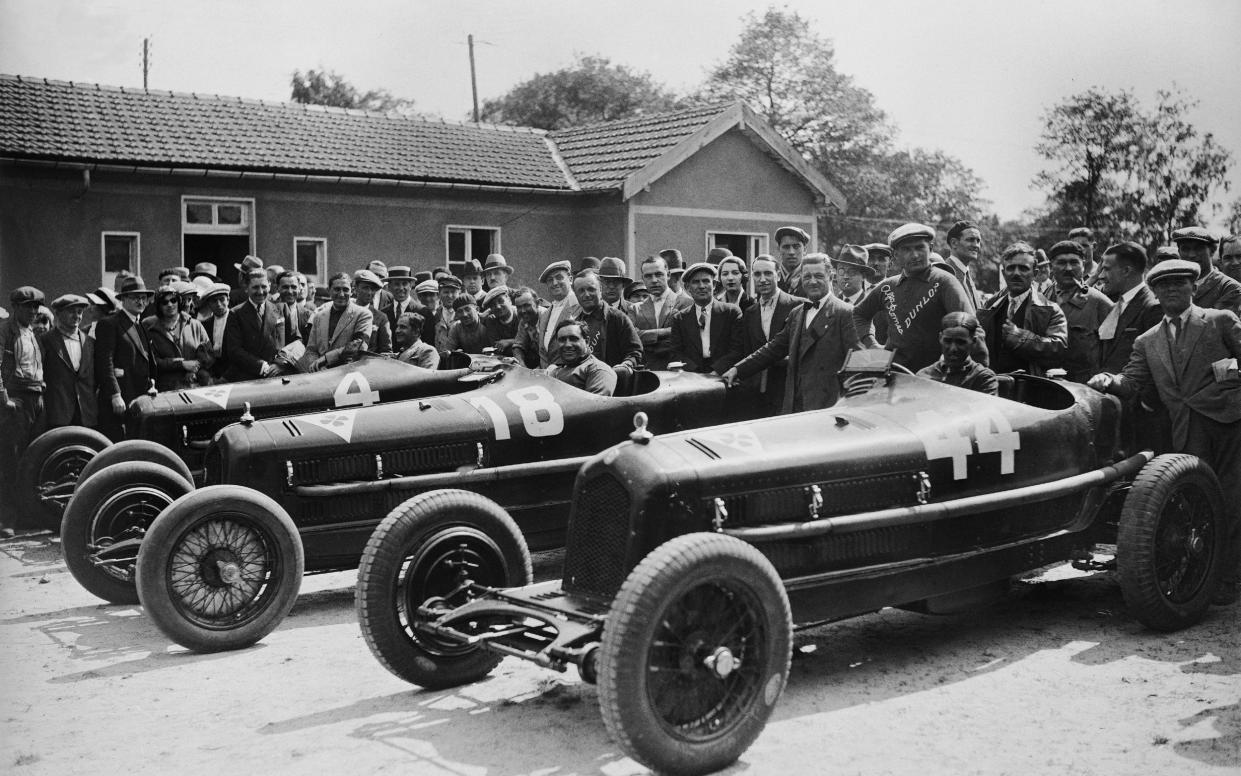
Indianapolis came next in 1909, not concrete but bricks, after its originator Carl G Fisher experimented with a rather disastrous initial surface of crushed stone pushed into a mix of tar and oil. These days “The Brickyard” is a full Tarmac circuit still used and revered by racers.
The German Avus ring opened in 1921 and although it is always shown as a banked circuit, it was principally two long straights linked by high banking. It was used as a motor racing circuit until 1998. In 1927, the German Nürburgring opened, which was principally a road-type circuit but with its own heavily-banked Karussell curve.
The steeply banked 1.242-mile track at Autòdrom de Sitges-Terramar opened in October 1923. Part of a model garden town project promoted by industrialist Francesc Armengol, it was cashing in on the concrete bowl craze and the garden town movement. It was surrounded with financial controversy though, with the builders seizing the gate money for the first race meeting and the circuit was banned from holding international meetings. It soldiered on hosting minor car and motorcycle races, but in 1929 it was seized by the state over unpaid bills. It’s still there, but in a poor state, though there is a plan to revamp the track as a centrepiece of a leisure and equestrian centre.
Monza, built in the park of the Royal Villa of Monza, north of Milan, did have banked corners when it was built in 1922, but the true 2.6-mile banked oval (Pista di Alta Velocità) was only completed in 1954. Though Formula One did use the oval portion of the track, it was eventually deemed too dangerous and after a last attempt in 1963, a protest by the teams saw it abandoned as part of the race circuit.
In Britain road racing was banned in 1925 after a spectator died at Kop Hill Climb in Essex. France, however – a less densely populated country – was, as Boddy notes, “where motor racing was born and where public roads could so easily be requisitioned for a motor race, [and] did not feel the need for a closed special course as early as some countries”.
In the 1920s, not one but two circuits opened in la belle France. The Miramas Autodrome, a 3.11-mile gently banked circuit near the Rhone estuary in the south of the country, was the longest banked track ever used for motor racing. It was built as a collaboration between the Automobile Club of Marseille and Paul Bablot, the well-known French racing driver. Its inauguration was inauspicious, however, as the organisers failed to secure the 1924 Grand Prix de Provence and instead held a minor cyclecar event.
It was also infamous for hosting two of the worst motor races ever held, the 1926 Grand Prix de l’Automobile Club de France where only Bugatti turned up with three factory cars which roared round for five hours with just one finishing, and the wash-out 1927 event which was postponed for five hours with most of the noted runners withdrawing and when it was eventually started it ran for just five laps before enraged and soaking spectators stormed the track. As a result, the promoting company collapsed and racing stopped in 1933. It is now part of an extensive BMW testing facility.
Montlhéry: the beginning
Work on the Autodrome de Linas-Montlhéry commenced in 1924 using Italian labour. The project was financed by industrialist Alexandre Lamblin, who had purchased a chateau and 12,000-acre estate close by the main Paris-to-Orleans road, on which in 1924 the redoubtable Ernest Eldridge had taken the world land speed record in his 300hp Fiat Mephistopheles at 146.01mph.
Lamblin hired René Jamin to design the 1.583-mile oval track. The aim was to build the world’s fastest motor racing venue, only 15 miles from the centre of Paris. More than 2,000 men worked on two shifts from 4am to 10.30pm to lay 35 metres of ferro concrete a day. The chateau became the clubhouse, and under the home banking a series of lock-up garages were built. A concrete road circuit was also built linked to the banking, which at one time gave a complete circuit length of 7.8 miles.
With Brooklands in Surrey suffering noise restriction and increasing bureaucratic red tape, racers and record-breakers were looking forward to the unrestricted space of the Montlhéry track where speeds of up to 155mph were expected…
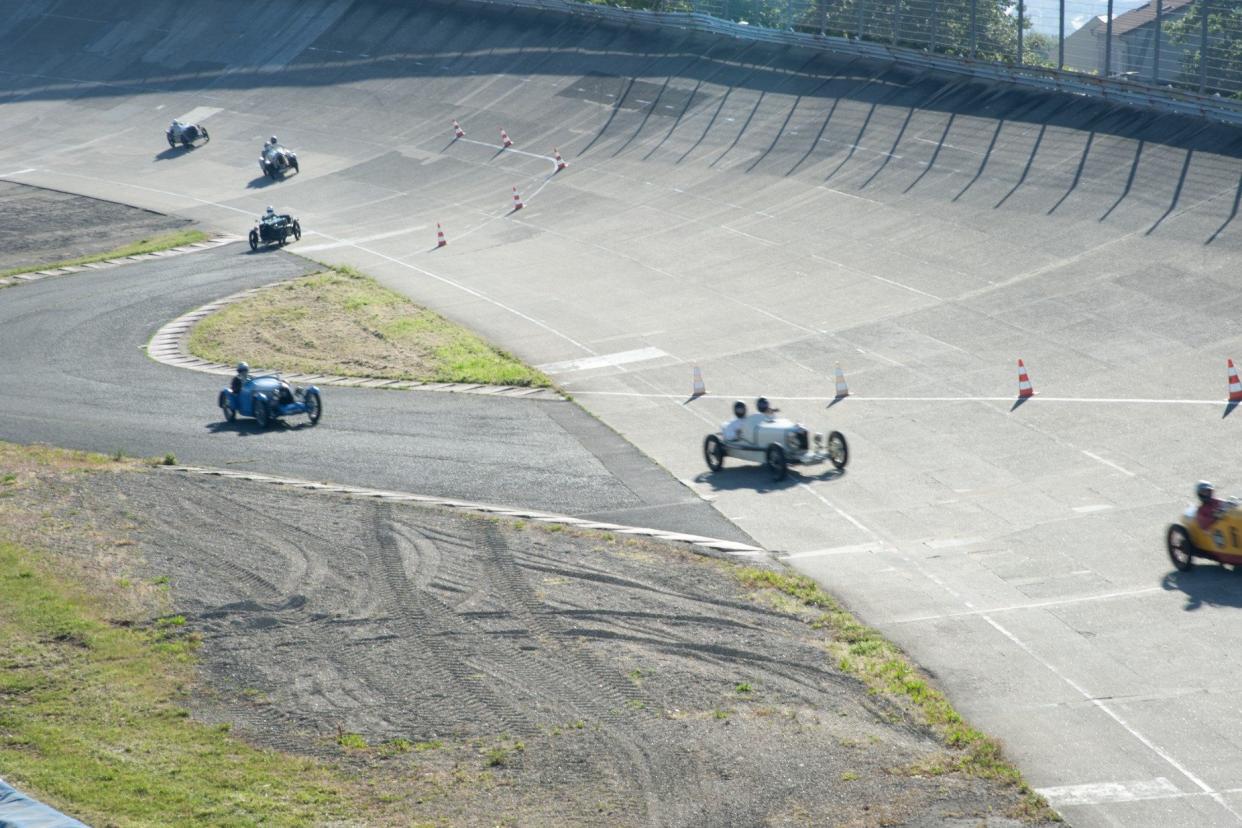
The first meeting on October 4 and 5 1924 was a low-key affair, with lots of short cyclecar and motorcycle races, although the draw of a six-lap match race between Eldridge in Mephistopheles, Parry Thomas in the Leyland Eight and Arthur Duray in a 120bhp D’Aoust would have encouraged attendance.
Such was the French pride in their 7.767-mile circuit with its banked oval that the year after its inauguration, the French Grand Prix was moved from Lyon to the Autodrome de Linas-Montlhéry.
Sir Henry Seagrave put his grand prix Sunbeam on pole, but after 80 laps and 621 miles, it was Robert Benoist and Albert Divo’s Delage which took the chequered flag.
Apart from considerable driver apathy towards the 51-degree concrete banks, the race also marked the terrible death of Antonio Ascari, father of Alberto who became a two-times Formula One world champion. The crash occurred towards the end of the race when light rain had begun to fall. Ascari misjudged the fast left kink coming off the banked oval part of the course and his Alfa Romeo P2 turned over. He died on the way to hospital. His death was widely mourned locally where his body was laid out in an Alfa Romeo red shirt for mourners to pay their respects, then taken to Italy where the train was covered in mourners’ flowers including a bunch from Benito Mussolini.
Inclement weather
High on a hill in the middle of a forest above the town of Arpajon, Montlhéry gets most of the weather that’s going and it’s played a big part in the history of the track. Perhaps that’s why Freddie Frot, co-organiser of this year’s Vintage Revival at Montlhéry, made special mention of the climatic conditions in his drivers’ briefing.
“We are expecting rain on Sunday afternoon,” he warned, “so you need to be incredibly careful as the track gets very slippery.”
In his foreword to Boddy’s book, Captain George ET Eyston, noted record-breaker, recalls the hidden menace of ice forming on top of the hill on which Montlhéry is sited.
“We were attempting to walk down this steep hill on a wintery day [and] to our amusement, the ferocious Alsatian from the local estaminet came rushing out to attack us. The dog struck the ice and went slithering on all fours out of sight down the incline…”
Centenary celebration
This year is all about celebrating the centenary, but Montlhéry is far from a crumbling monument to old glories. I rode my Triumph Tiger to the first celebration at the circuit’s Vintage Revival in May.
Held every year this is a joyous event, hosting period cars, motorcycles and bicycles, all lapping the old circuit under controlled if healthily speedy conditions. What’s wonderful is its egalitarian nature; everything is there, from Bugatti race cars worth many millions to rusty powered bicycles you’d pay to have taken away.
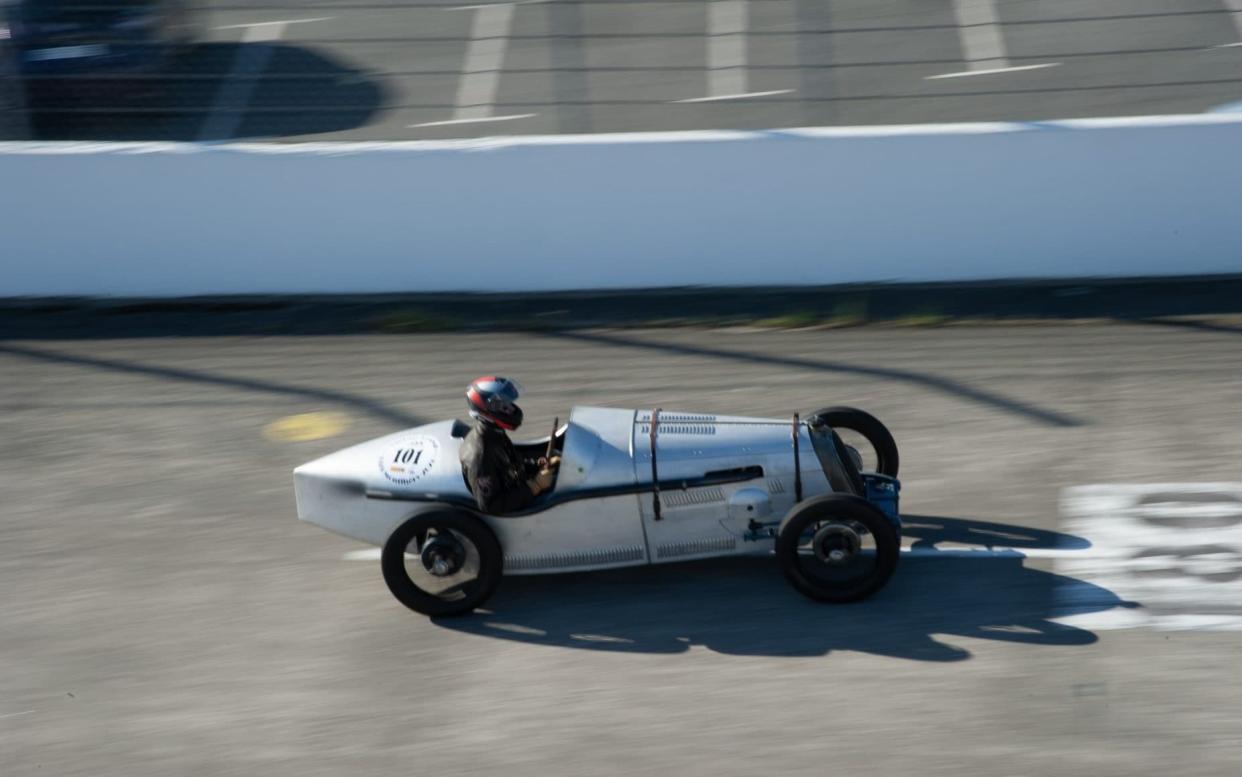

And unlike UK classic events where there are endless supplementary costs to watch the cars, buy a decent cup of tea or even breathe the air, the Montlhéry entry ticket covers everything. You want oysters and champagne? There’s a Citroen H-Type van over there and you sit on their iron garden furniture. Want to picnic under the trees? No problem, select your spot. There’s good coffee, excellent ices and piquant merguez sausage in a baguette. What’s not to like? The event might be comfortably south of over-organised, but the welcome is warm and the local bed and breakfasts are terrific.
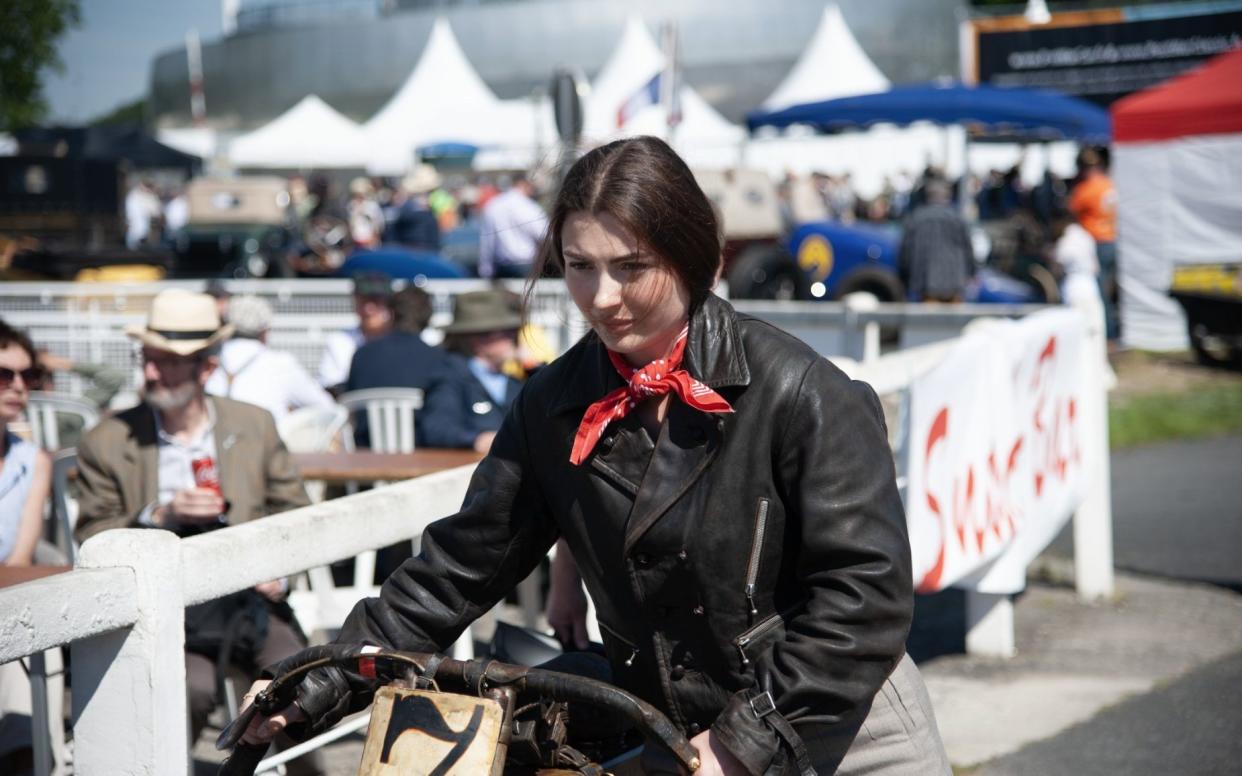
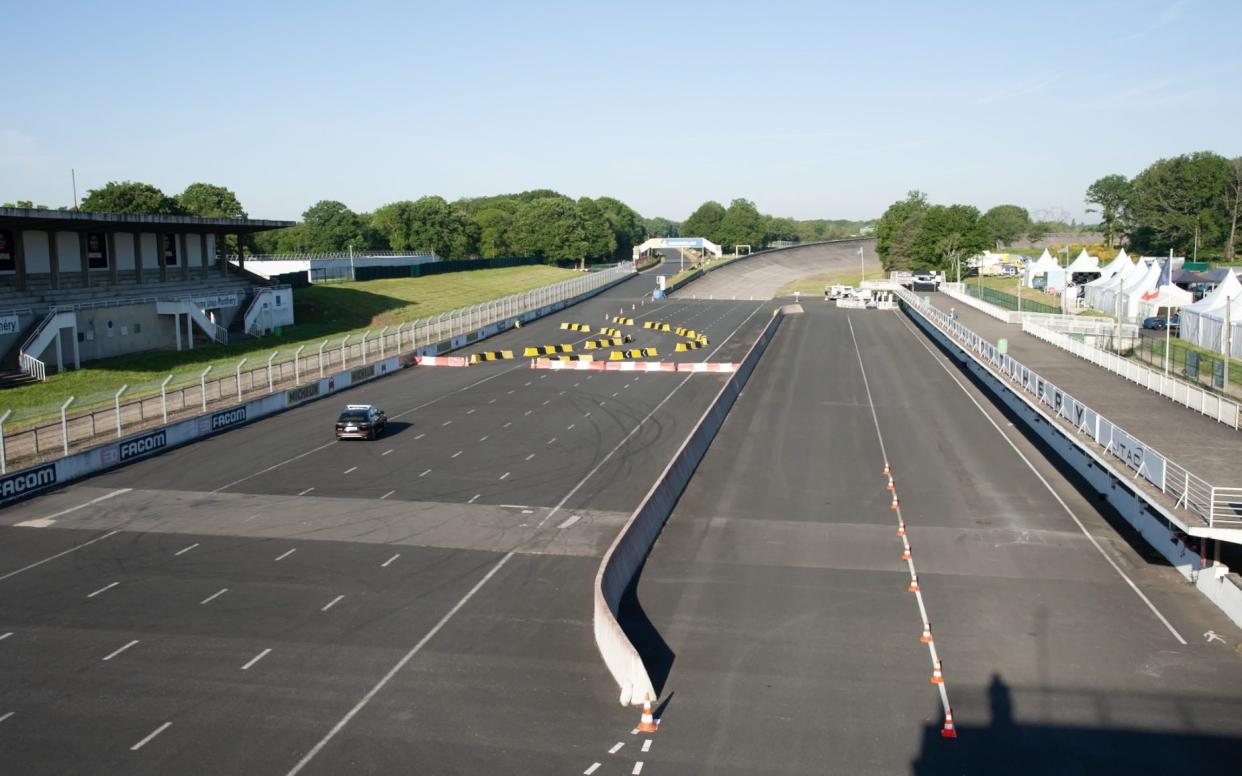
I’ve been here before. It used to host the Coupes Moto Legende before it moved to Dijon and I rode a vintage BMW race bike on the long circuit. The top of the banking at 80mph with a gentle tankslapper just a few seconds away is something I’ll not forget in a hurry. My friend Geoff Harris raced his Lola T70 here, which he described as “ultra scary”.
It hosted the French Grand Prix between 1931 and 1937, but in 1939 it was sold to the government, which sold it on to the testing organisation Union Technique de l’Automobile et du Cycle (UTAC) in December 1946. It’s still a testing site and headquarters to UTAC, which also owns test facilities at Millbrook in Bedfordshire and Mortefontaine north of Paris. Fun fact: when testing, they use the banking in anticlockwise fashion, but the racers always used it clockwise.
Ghostly vibe
That contemporary testing requirement gives it a strange ghostly vibe. The faded oil and spark plug advertisements are the real thing, and if you listen carefully you might just hear those heroes of the banked track and their aero-engined monsters. But there’s none of the ossified reverence you get at Brooklands or Monza. Here everything earns its keep and if the ancient concrete needs repairing then unlike Brooklands, where the surface isn’t allowed to be touched, Montlhéry gets repaired.
“We are the owner of the circuit so we are allowed to do what we want with it,” says Laurent Benoit, UTAC chairman, though he’s not quite the heathen that this quote implies.
“We try to do the work so that we can do both technical work and historic events like this,” he adds.
He explains that the “ring” is not used much for testing and that UTAC puts quite a lot of investment into its old structure to keep it usable for these events.
In fact, UTAC is hosting its own centenary event this year on October 12-13 with more than 300 cars and motorcycles on the track, including endurance racers from the original 1,000km de Paris races which were held at Montlhéry, along with 1950s and 1960s cars, as well as a category for “Young Timers”. There’ll be all manner of activities and fun all timed to coincide with the Paris motor show, so it might well be worth a visit.
The circuit soldiered on for years, hosting several important record-breaking attempts since it can be used at night, unlike a lot of its contemporaries. These days it’s a working facility, but somehow combines that with being a place of pilgrimage for petrolheads, which looks forward as much as it looks back. In 2010 it even hosted rally driver and stunt performer Ken Block for his Gymkhana 3 video in a 650bhp Ford Fiesta.
Freddie Frot of the vintage revival seemed pleased with his organisation’s contribution to the centenary. “We have rehearsed it for six years, so it’s a well-oiled machine. Nonetheless with a bigger participation than ever, it has been a challenge, which all our volunteers have pulled off. And we’ll be back next year, of course.”
And do you know what? I think I might be, too.
Thanks to DFDS for our Dover to Calais ferry crossing. The company runs regular services between Dover to Calais and Dunkirk as well as Newhaven to Dieppe: dfds.com


